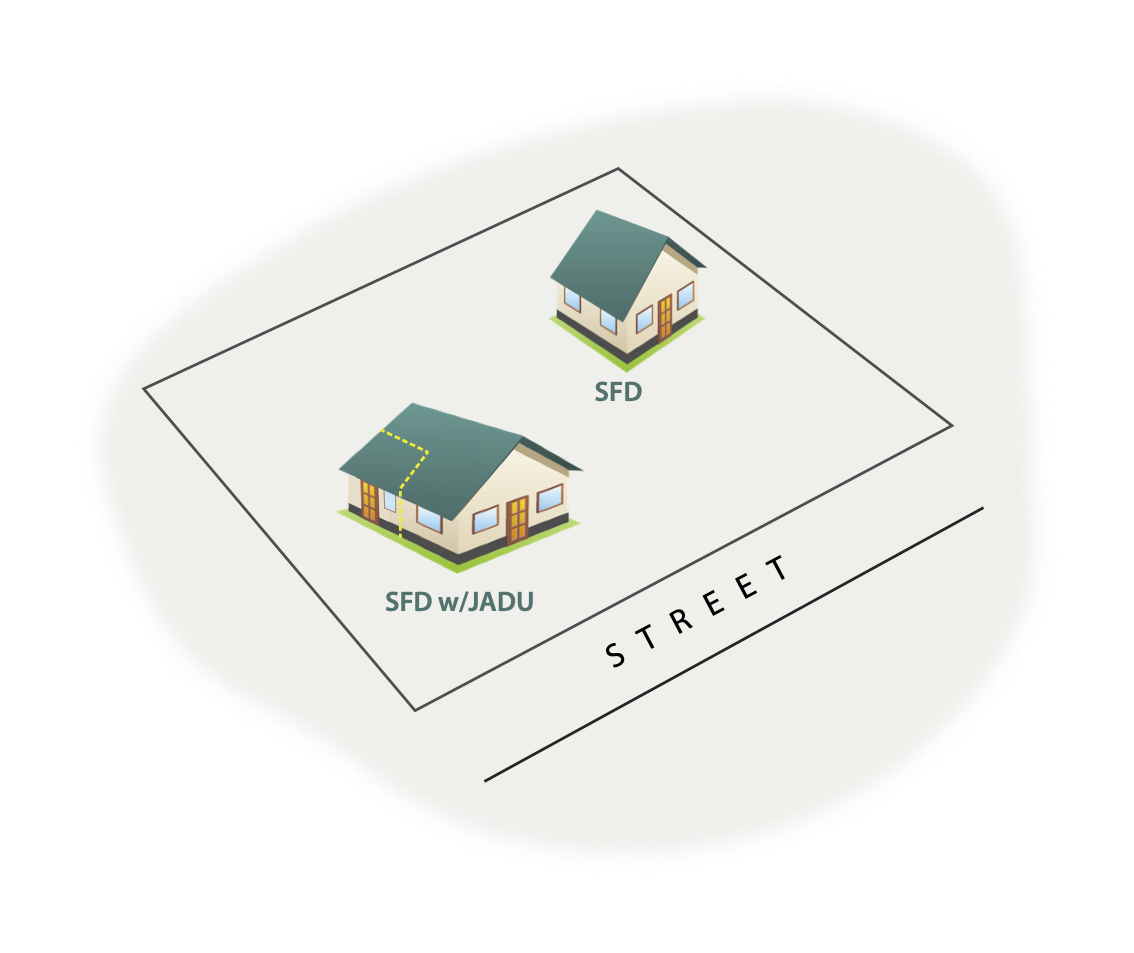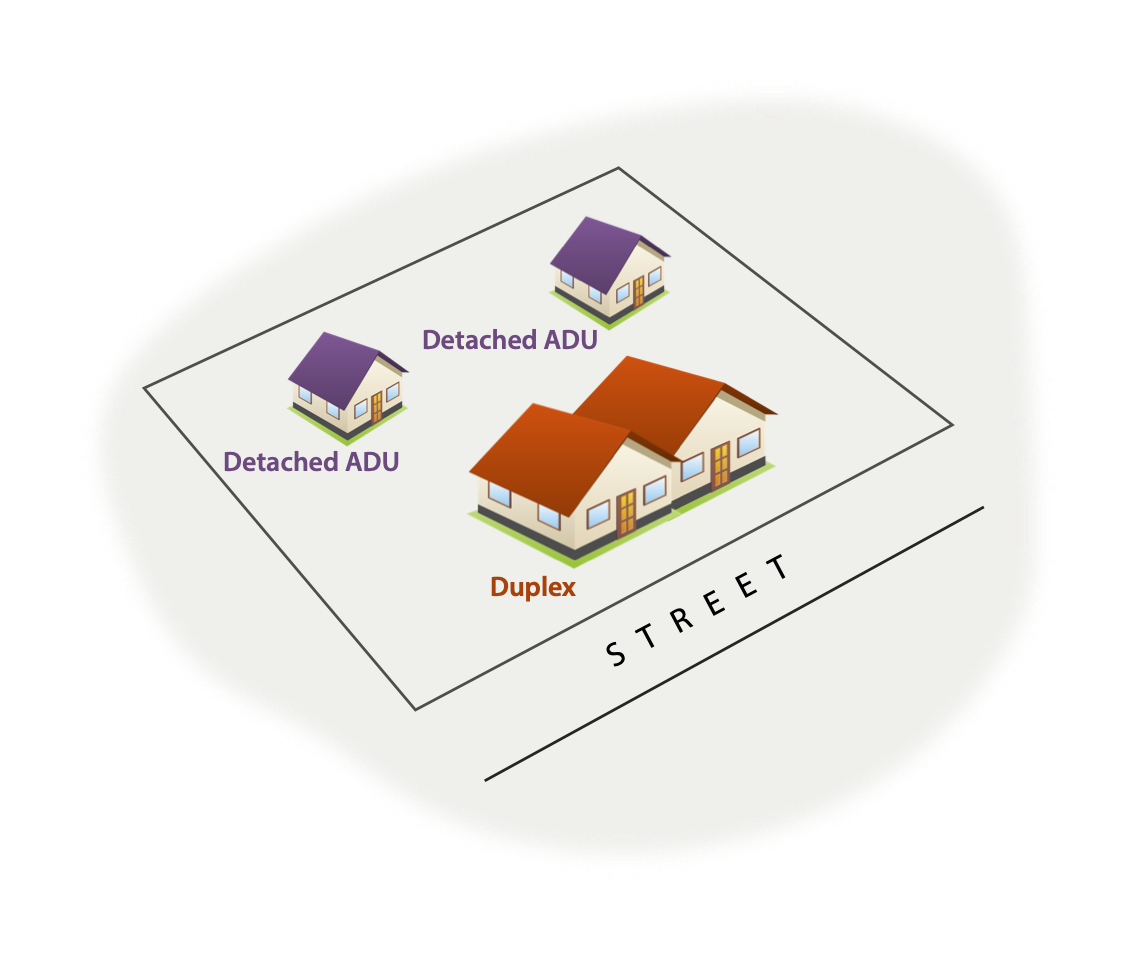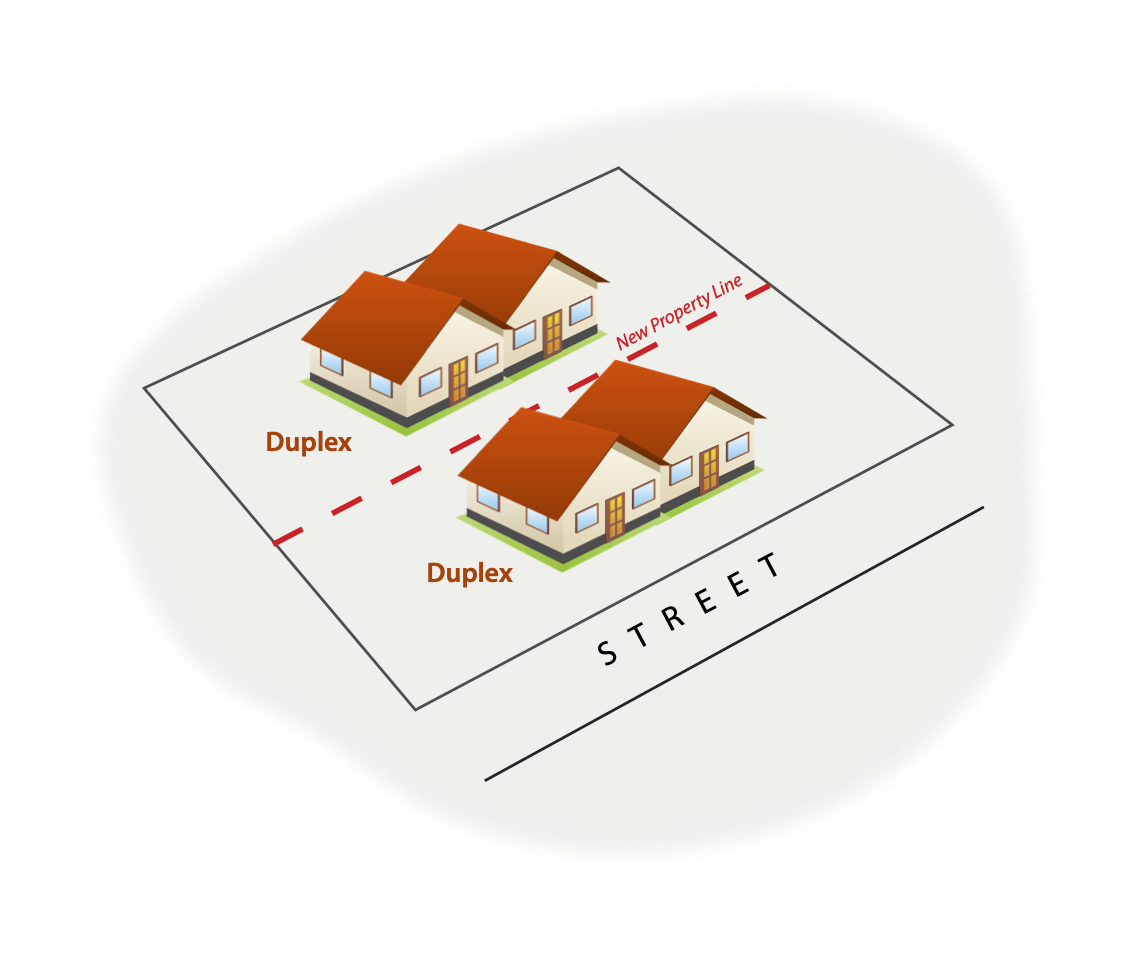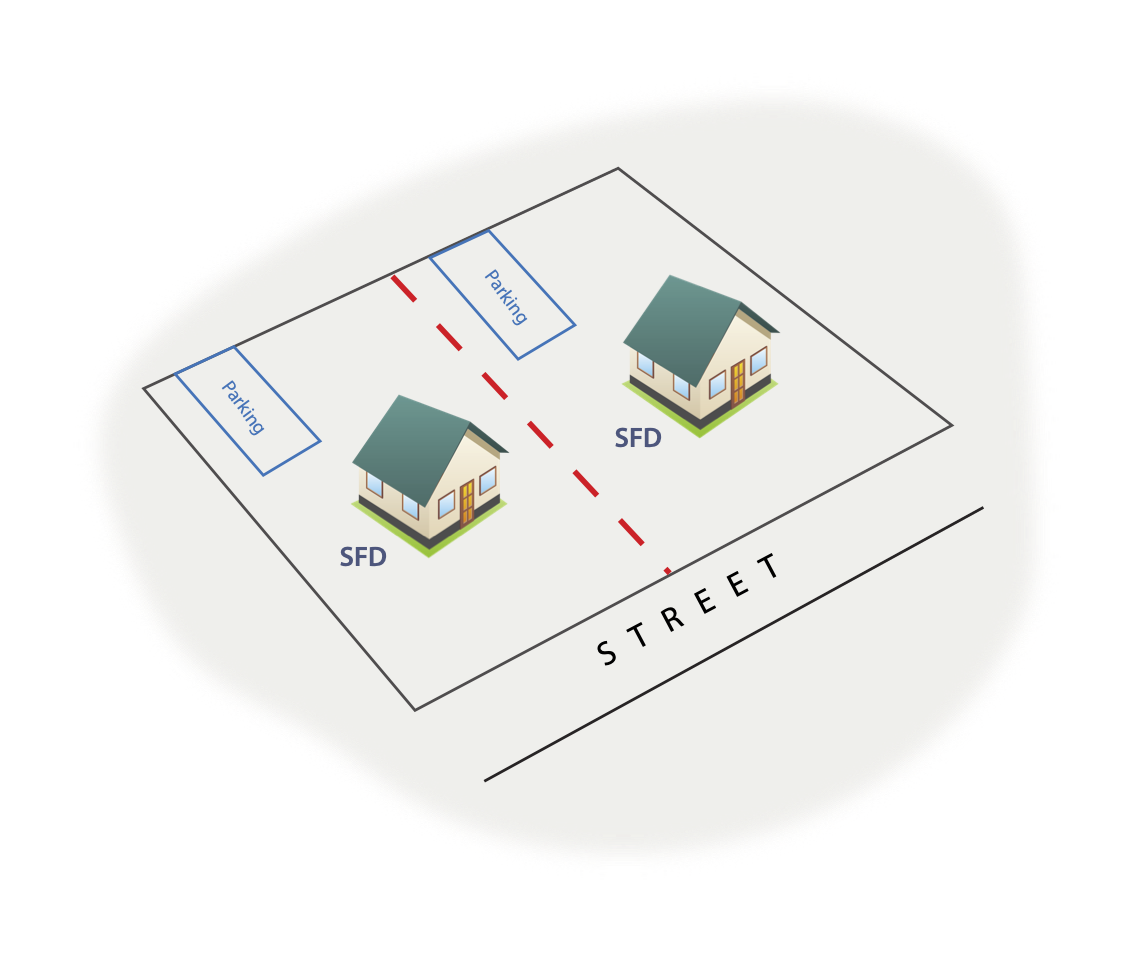Introduction
Senate Bill 9 (SB 9), the Housing Opportunity and More Efficiency (HOME) Act, is a California law that aims to increase housing supply across the State through streamlined measures that expand infill development opportunities, including making it easier to apply for a lot split or two-unit development on a single-family zone. This only applies to single-family zones and may or may not include an ADU or a JADU.
This bill went into effect on January 1st, 2022 and requires all local agencies to approve a proposed housing development containing no more than two residential units on a lot within a single-family residential zone, with a ministerial permit, if the development meets certain criteria as described below.
The bill also allows the subdivision of one lot into two lots (“lot split”) within a single-family residential zone with a ministerial permit, if it meets certain criteria as described below. Each newly created lot, after subdivision, can accommodate up to two units on each lot.
Key Components
Two Unit Developments
Permits and streamlines the process for the development of two primary dwelling units on single-family (R-1) zoned lots. It does NOT apply in any other zoning districts including R-2, R-3, or R-4 zones, or office, commercial, and manufacturing zones. Please see examples below.
Lot Splits
Permits and streamlines the process for subdividing an existing single-family zoned lot into two individual parcels without having to meet the minimum lot size required by the underlying zone. A lot split is required in order to allow for the units to be sold separately. Please see examples below.
Development Scenarios
These examples illustrate some of the most common development scenarios and do not represent every possible lot/unit configuration. Below are some examples of lot splits to accommodate ADU’s and JADU’s.
Lot split with flag lot configuration with SFD and Junior Accessory Dwelling Unit (JADU) on one lot and an SFD and a detached Accessory Dwelling Unit (ADU) on the other lot.






Lot Split with SFDs and ADU/JADUs; Zero parking spaces required per unit if within 1/2 mile of a High Quality Transit Corridor or Major Transit Stop. See Key Development Standards below.
Examples of Lot Splits Without ADU’s or JADU’s

Lot Splits & Two Unit Developments
No ADU’s or JADU’s would be allowed under these examples.



Side and rear yard setbacks are required to be a minimum of 4 feet. Front yard setbacks shall be the same as required by the underlying zone. Please refer to the Planning and Zoning Search for setbacks and other applicable requirements for the subject property zone. No setback is required for a legally existing structure under this example.

Helpful Resources
Planning & Zoning Search
Web Link
Single Family Zoning
Web Link
Key Development Standards for Development Under SB9
- Front yard setbacks shall be the same as required by the underlying zone. Side and rear yard setbacks are required to be a minimum of 4 feet.
- SB 9 projects shall be required to provide one covered (SB9 does not require it to be covered but we can) parking space per existing and new unit, or no parking space if a site meets the parking exemption criteria, which includes being within a half mile of a High-Quality Transit Corridor or Major Transit Stop. The determination as to whether a location qualifies as either a Major Transit Stop or High-Quality Transit Corridor shall be determined by the City of Oxnard,
Additional Standards For Lot Splits Only
- The maximum number of lots allowed for a Lot Split is two lots.
- No resulting parcels may be smaller than 40 percent of the lot area of the original parcel proposed for subdivision. Furthermore, both new lots must be at least 1,200 square feet.
- A maximum of two dwelling units of any kind (including primary units and ADUs/JADUs) are permitted on a lot created through a Lot Split.
- Please refer to the Planning and Zoning Search for setbacks and other applicable requirements for the subject property zone.
Frequently Asked Questions
Senate Bill No. 9 (SB 9), signed into law by Governor Newsom on September 16, 2021, requires all local agencies to approve a proposed housing development containing no more than two residential units on a lot within a single-family residential zone, with a ministerial permit, if the development meets certain criteria as described below.
The bill also allows the subdivision of one lot into two lots (“lot split”) within a single-family residential zone with a ministerial permit, if it meets certain criteria as described below. Each newly created lot, after subdivision, can accommodate up to two units on each lot.
The complete bill text is available here: https://leginfo.legislature.ca.gov/faces/billNavClient.xhtml?bill_id=202120220SB9
The legislation went into effect January 1, 2022.
Multiple units may be constructed on an eligible lot pursuant to SB 9:
- Lots without a lot split may be constructed with two detached single-family units or one two-family unit in addition to two Accessory Dwelling Units (ADUs) as permitted by law.
- With a lot split, up to two units may be constructed inclusive of any combination of ADUs and/or JADUs, on each of the newly created lots.
Please see below for more information regarding ADUs and JADUs.
A ministerial permit is a permit that is granted based upon determinations that the proposed project complies with established standards and criteria set forth in either the Coastal Zoning Ordinance or Non-Coastal Zoning Ordinance, and/or state law. These determinations are arrived at objectively by the Planning Director or his/her designee. A ministerial permit does not include discretionary review, i.e., they are not open to personal interpretation or preference. Additionally, such projects do not require environmental analysis (CEQA) or public hearings.
ADU and JADU laws pursuant to Gov. Code § 65852.2 and Gov. Code § 65852.22 will continue to apply to eligible properties provided they do not utilize both the two-unit development and lot split provisions of SB 9.
For example, an applicant with an existing legally permitted single-family dwelling unit on an eligible lot can seek permits to build a second single-family dwelling unit on that lot using SB 9. Assuming the applicant is not also pursuing a lot split, the lot could be developed with any additional ADUs or JADUs that may be allowed pursuant to the ADU and JADU laws.
However, if a lot with an existing ADU is subdivided pursuant to SB 9, the existing ADU will count toward the maximum allotment of two units per each newly created lot. No more than two units (inclusive of ADUs and JADUs) per lot will be allowed on lots created through SB 9.
Please contact the City of Oxnard, Community Development Department at [email protected], or by calling (805) 385-7858.
No, state law prohibits rentals less than 30 days for two-unit residential development projects. You will be required to record a Covenant that outlines the requirements regarding the rental terms of a two-unit residential development project.
Yes, a property being located within a Coastal Zone would not preclude it from being eligible for SB 9; however, SB 9 does not supersede the application of the California Coastal Act (Public Resources Code Section 30000), or the current Coastal Development Permit (CDP) procedures required by the Oxnard City Code. The CDP procedures require a discretionary filing and public hearing for a CDP for any demolition, conversion, new construction, and/or subdivision, and a public hearing.
No, owner-occupancy is not a requirement for two-unit residential development. However, in order to approve an urban lot split, the property owner must sign a statement indicating that the owner intends to occupy one of the housing units located on a lot created by the parcel map as their principal residence for a minimum of three years from the date of the recording of the parcel map.
SB-9 does not allow the demolition or alteration of the following:
- Housing that is subject to a recorded covenant, ordinance, or law that restricts rents to levels affordable to persons and families of moderate, low, or very low income
- Housing that has been occupied by a tenant in the last three years
Disclaimer
The Building and Engineering Division may determine a project is not eligible for review based on site conditions, project scope, non-permitted construction, or other project conditions. The applicant acknowledges that preliminary review by the City of Oxnard Planning Division is required prior to plan submission.
Questions?
For additional information regarding the single family zone please visit the Planning Department.